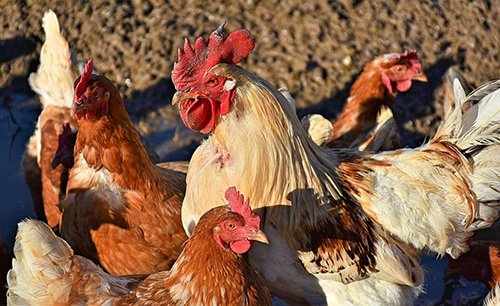Contents
- 1 All About Eggs: A Nutritionally Complete Food
- 2 All About Eggs: Processing
- 3 All About Eggs: Substitutes
- 4 All About Eggs: Proteins
- 5 All About Eggs: Benefits
- 6 All About Eggs: Drawbacks
- 7 All About Eggs: Cholesterol
- 8 All About Eggs: Hygiene
- 9 All About Eggs: Varieties
- 10 All About Eggs: Size
- 11 All About Eggs: Structure
- 12 All About Eggs: Nutritional Value
So, you want to know all about eggs? Well, you have come to the right place. You will learn scientific facts, facts about its cooking, and much more. The egg is a hard-shelled reproductive body produced by a bird. It contains the germ of new life and the nutritional reserves it will need to develop. When a specific bird is not named, the egg refers to that of the hen, a female of the species Gallus gallus. A fresh egg has not been processed in any way other than refrigeration for 30 days.
Oviparous (egg-laying) animals such as insects, amphibians, fish, and birds are those that, as the name implies, reproduce using eggs; in contrast to the young of viviparous animals, which gestate within the mother’s body and are born alive, the offspring of egg-layers form within an egg after being expelled from the female’s body. Therefore, everything necessary for life is contained within the egg.

All About Eggs: A Nutritionally Complete Food
Each egg consists of two well-differentiated parts:
- Germinative vitellus or embryonic disk is formed by the germinal cell, with its nucleus containing genetic information. This part of the egg will become the embryo.
- Nutritional vitellus is formed by the reserve nutritional substances the embryo uses as it develops.
Bird eggs are noted for their high proportion of nutritive reserve, including egg white and most of the yolk. The embryonic disk is a tiny red dot on the yolk’s surface.
During the three weeks of incubation, the yolk and egg whites are the only nutrition sources for the developing embryo. From them, the embryo gains all of the substances needed to form tissues, including bones and feathers.
It is unsurprising that bird eggs are among the most nutritionally complete foods found in nature. Humans can benefit from this tremendous nutritional reserve. However, to better understand its properties, benefits, and drawbacks, one must remember that the egg’s biological objective is exclusively the formation of a new bird.
All About Eggs: Processing
Eggs have a concise and beneficial life since they spoil rapidly and become a breeding ground for numerous microorganisms. Therefore, eggs are industrially processed in various ways to prolong their life and minimize microbiological contamination. They are thus converted into “egg products.”
After removing the shell, the egg white and yolk are treated, either together or separately, with one or more of these processes:
- Pasteurization: As with milk, eggs are heated long enough to destroy all pathogens. They are usually heated to 60-65 degrees Celsius (140-149 Fahrenheit) for two to three minutes.
- Freezing: This must be performed only in an industrially controlled setting since the temperature must be maintained between 0 and -2 degrees Celsius (32 degrees and 28.4 Fahrenheit). Deterioration of the egg’s properties results at lower temperatures.
- Dehydration involves removing the water until the white and yolk are reduced to powder. This is the safest way to store eggs.
Egg products are recommended in food service establishments, whether a restaurant or a food truck, to prepare mayonnaise and sauces. Egg products help avoid salmonellosis and other intestinal infections caused by microbial contamination of fresh eggs.
All About Eggs: Substitutes
The food industry has developed products that can be effectively substituted for eggs in culinary applications but with the following advantages:
- They contain no cholesterol,
- They provide about 75 kcal/ 100 g; in other words, only half the calories of an egg,
- They contain less sodium than eggs,
- They produce no allergies if they are complete substitutes
- There is no risk of salmonella contamination.
There are two types of egg substitutes:
- Complete substitutes are made from a base of soy or milk, corn oil, and flavorings, but without egg.
- Partial substitutes include egg white, but not the yolk, which contains all of the egg’s cholesterol and the above ingredients.
Due to their binding and emulsifying qualities, egg substitutes perform as well as eggs for most cooking applications, including omelets and souffles.
All About Eggs: Proteins
Proteins constitute the essential nutrient found in eggs. This is due to their amount (about 7.3 g in a 65 g egg), as their quality, which is the highest of any food.
Egg white proteins (4.2 g per egg):
- Ovalbumin is the most abundant since it forms half of the egg white protein. It is responsible for foaming when the egg white is beaten and its coagulation when heated.
- Conalbumin represents 13 percent of the protein in the egg white.
- Ovomucoid is a hypoallergenic glycoprotein that is responsible for most egg allergies.
- Ovomucin is another glucopotein found in the membranes and chalaza, giving them viscosity and resistance.
- Globulins are present in small quantities but play an essential role by acting as enzymes. The most important is lysozyme, which has an antibacterial action.
- Avidin is a protein first identified in 1940 and is the least present in egg whites. It interferes with the absorption of biotin, a B complex vitamin found in the yolk. When the egg is cooked, heat renders avidin inactive.
Egg yolk proteins (3.1 g per egg):
- Phosphoproteins are those linked with phosphoric acids, such as phosvitin.
- Lipoproteins are attached to lecithin and other phospholipids, such as vitellin.
All About Eggs: Benefits

- Nutritious: Eggs provide the most complete protein of any food, together with fats, vitamins, and minerals.
- Promote healthy growth: Although they are not essential, as is the case with any single food, eggs can significantly contribute to the nutritional needs of children and adolescents during periods of rapid growth.
- Easily digested: The egg’s proteins, fats, minerals, and vitamins are easily digested, and most are assimilated. The fats in the yolk are emulsified, thus facilitating their digestion. The exemption here is iron, which, like that in vegetable foods, requires vitamin C to promote absorption.
- Eggs do not produce uric acid: Unlike other protein sources such as legumes, fish, or meat, eggs produce virtually no uric acid in the body.
- Culinary possibilities: Eggs (and their substitutes) are an ingredient in many culinary creations and other preparations due to their emulsifying, binding, and thickening properties. Additionally, eggs add nutritional value.
Are Eggs Bad for The Liver? There is a widespread belief that eggs are harmful to the liver. This is not the case. The amino acids that compose their proteins and the vitamins they provide greatly value the hepatic gland.
Eggs are permitted in the liver patients’ diet in moderation, taking care of the total fat intake. However, the yolk’s fats provoke an intense draining of the gall bladder, located just under the liver. This can produce digestive disorders, including colic, particularly in gallstone patients.
All About Eggs: Drawbacks

- Deficient in some nutrients: Eggs contain little to no carbohydrates, fiber, and vitamin C.
- Allergies: Ovomucoid, a protein in egg white, is the genesis of most cases of egg allergy found in children and adults. Yolk proteins can also produce allergies. It is calculated that one-third of food allergies in children can be traced to eggs. Egg allergies manifest the following primary symptoms
– cutaneous: skin rashes, eczema, dermatitis, and atopic manifestations;
– digestive: abnormal pain, colic, diarrhea;
– respiratory: asthma attacks that may be initiated or aggravated by egg
consumption.
Eggs produce fewer allergic reactions when they have been thoroughly hard-boiled. - Bacterial contamination: Birds possess a common chamber into which the intestinal, urinary, and genital canals discharge, called the cloaca. As it is laid, the egg comes into contact with the hen’s feces, containing numerous microbes, including the feared salmonella.
A study conducted in Hanover (Germany) confirmed that the principal source of salmonella contamination is the feed given to hens and chickens. The microbes pass through the bird’s intestine and into the egg from the feed. - Chemical contamination: Eggs may contain traces of heavy metals (cadmium, lead), pesticides, and antibiotics administered to the hens.
- Cholesterol and arteriosclerosis: Egg consumption elevates blood cholesterol levels, but not by as much as was once thought. However, the worst is that it promotes arteriosclerosis.
- Sodium rich: Eggs are one of the natural foods richest in sodium. At the same time, they are a poor source of potassium. For this reason, they must be used with prudence in cases of arterial hypertension.
- Cancer: A team at the University of Minnesota studied the relationship between egg consumption and cancer. This study concluded that there is a statistically significant relationship between eating eggs and colon cancer. This relationship is more evident in women who eat eggs daily. They are at eight times greater risk of suffering cancer of the ascending colon. Another study carried out in China by the National Cancer Institute of the United States has found a positive relationship between egg consumption and stomach cancer.

It is important to learn all about eggs because they must not be included in a child’s diet before one year of age for two main reasons:
- To avoid allergic reactions.
- To prevent infections (salmonella).
After the first year, the egg can be given hard-boiled and in small quantities to check the child’s digestive tolerance.
All About Eggs: Cholesterol

The egg has gotten a negative reputation due to its high cholesterol content. Is the egg as harmful to cardiovascular patients as had been thought?
The egg is the richest of animal products in cholesterol. Only the brain tissue is higher. The egg contains so much cholesterol because this lipid is indispensable for the development of the embryo. However, humans do not need to take in cholesterol through their food since the liver can produce even more than the body needs.
One egg contains about 250 mg of cholesterol, an amount close to the 300 mg daily upper limit. This means that eating one egg a day and any other animal product (milk, meat, fish, etc.) substantially suppresses the 300 mg of cholesterol considered the maximum daily allowance.
Eggs raise cholesterol only slightly. A study at the Copenhagen Clinic for the Study of Preventive Health demonstrates that eating two hard-boiled eggs a day for six weeks produces
- An increase in HDL cholesterol (beneficial) of 10 percent.
- A slight increase in total cholesterol of four percent.

If this is the case with two eggs daily, it is reasonable to say that moderate consumption of two or three eggs a week does not raise blood cholesterol levels. In fact, cholesterol from food has a relatively limited impact on the blood levels of this lipid. Saturated fat increases cholesterol levels more than food cholesterol itself.
Even though eggs do not elevate cholesterol levels in the blood as much as once thought, they promote arteriosclerosis to a greater degree than was thought. Cholesterol is only dangerous when it is deposited on the walls of the arteries, which becomes hardened and narrower. Recent investigations have shown that this process, known as arteriosclerosis, is initiated by the oxidation of low-density lipoproteins (LDL), which transport cholesterol in the blood plasma.
Studies conducted at the Rambam Medical Center in Haifa (Israel) have shown that consuming two eggs a day for three weeks increases the oxidation of plasma lipoproteins by forty-two percent. This means that eggs promote the process of arterial deterioration and arteriosclerosis.
All About Eggs: Hygiene
When you learn all about eggs, you will discover that it is the ideal medium for the development of microorganisms. Although they contain protective membranes and antibacterial proteins such as lysozyme, many commercially available eggs are contaminated, even in developed countries.

A study conducted at the Institute of Social Medicine and Epidemiology in Berlin (Germany) shows that salmonella bacteria in eggs are responsible for sixty-seven percent of all food-related poisonings.
Tips on how to avoid egg-transmitted infections
- Do not eat raw eggs: Sauces, particularly mayonnaise, are excellent media for the development of microorganisms from:
– the egg itself
– external contamination from hands, hair, and saliva of those handling
the material during preparation.
Pasteurized egg products should be used in place of raw eggs.
- Discard eggs with cracked shells: Intact eggs may be contaminated with salmonella because bacteria penetrate the shell through its numerous pores. Those with damaged surfaces present an even greater risk of contamination.
- Discard eggs contaminated with feces on the shell: Washing does not eliminate the possibility of contamination since the microbes have usually already entered the egg.
- Store eggs in the refrigerator and never longer than three weeks.
- Use the freshest (most recently laid) eggs possible: The longer an egg is stored, the greater the possibility that bacteria have developed in its interior.
All About Eggs: Varieties

Brown eggs: Some believe that eggs with dark shells are more nutritious than those that are white. This is not true. The color of the surface depends only on the breed of hen.
Yellow yolks: Today, the yolk color is no longer a reliable indicator of whether or not the hen was naturally fed. The feeds used on high-production industrial farms contain various pigments that give the yolk the desired color.
Fertilized eggs: These are eggs whose germinal cell has been fertilized by a rooster. When they are incubated, they develop chicks. They are no more nutritious than unfertilized eggs, and they spoil faster.
Organic eggs: So-called “organic” eggs come from hens raised in the fresh air (not in industrial settings), fed on grain, vegetables, and organic feeds, without antibiotics, sedatives, hormones, or other additives.
Industrial poultry farms place hens in cages, where they have minimal movement and no natural daylight. They are artificially induced to produce various eggs a day. How can eggs from hens in these conditions equal nutrition and flavor to those from fowl living well-fed in the fresh air and laying only one egg a day?
Some consumers prefer organic eggs (from hens raised and fed naturally) because:
- Of their superior flavor and quantity
- They do not contribute to the exploitation of fowl in such an unnatural way.
Enriched or DHA Eggs: Enriched eggs come from hens fed with seaweed that contains omega-3 type polyunsaturated fatty acids. Among these, the most important is DHA (docosahexaenoic acid). Because of this, these are referred to simply as DHA eggs, as well.
Docosahexaenoic acid is an omega-3 series polyunsaturated fatty acid whose molecules are formed by 22 carbon atoms and six covalent bonds. It is found in fish oil. Hens that consume it with their feed incorporate it into their eggs.

Eggs of different birds: All bird eggs are edible, although those of the following species are preferred:
- Hen eggs are the most used throughout the world.
- Quail eggs are small, dark, and have a delicate flavor.
- Duck eggs are larger and with a thinner shell than those of hens. Their yolks are proportionally larger than those of hen eggs. They are very frequently contaminated with pathogenic microorganisms.
- Turkey eggs are somewhat larger and more elongated than hen eggs.
- Guinea fowl lay dark eggs that are smaller than those of the hen. They have a very delicate flavor.
- Goose eggs are enormous, up to 160 g. They have a strong flavor.
Egg products: These egg derivatives are obtained by pasteurizing the egg white, the yolk, or both, with or without dehydration. Sauces and other products made with egg products present no risk of salmonella contamination.
Egg substitutes: These are a healthy, beneficial alternative to eating eggs.
Raw eggs contain avidin, a protein that interferes with the absorption of vitamin B or biotin. Raw eggs can also transmit pathogenic bacteria such as salmonella. For these reasons, eggs must always be properly cooked before they are eaten.
All About Eggs: Size
In the European Union, eggs are classified according to the weight of the egg:
| Small (S): | 43-53 g |
| Medium (M): | 53-63 g |
| Large (L): | 63-73 g |
| Extra-large (XL): | More than 73 g |
In the United States of America, eggs are classified according to minimum weight per dozen:
| Small: | 18 oz. = 509.4 g per dozen |
| Medium: | 21 0z. = 595.6 g per dozen |
| Large: | 24 oz. = 680.6 g per dozen |
| Extra-large: | 27 oz. = 765.7 g per dozen |
| Jumbo: | 30 oz. = 850.8 g per dozen |
All About Eggs: Structure

Shell: The eggshell has a protein base (four percent of its weight) that contains many calcium carbonate crystals (ninety-five percent of its weight). It is permeable. The shell of each egg has about 8,000 pores that permit:
- A portion of the water within the egg to evaporate over time, and
- Air and microorganisms to enter the egg.
Embryonic disk: This is a spot on the yolk containing the germinal cell or ovum with its nucleus. If the egg has not been fertilized, the nucleus of this cell contains only the hen’s chromosomes. If it has been fertilized, it contains the chromosomes of the rooster’s sperm as well, with all the genetic information needed to create a new life.
Egg white: The egg white is formed almost entirely of water and protein. The white of a 65 g egg contains 4.2 grams of various proteins, predominantly albumins.
Chalaza: This is a thickening of the vitelline membrane that maintains the yolk in the center of the egg. It is formed of a type of protein called ovomucin.
Air space: This is formed between the two membranes that protect the egg white. It becomes more significant with time.
Membranes: Membranes protect the contents of the egg, even though they are quite porous. Two membranes surround the egg white and one, called the vitelline membrane, surrounding the yolk.
Yolk: The yolk contains the greatest concentration of nutrients within the egg. Its primary contents are:
- Proteins
- Fats
- Minerals
- Vitamins A, D, E, and B.
The typical yellow color of the yolk is attributed to xanthophyll, a non-nutritive carotenoid. An intense yellow yolk indicates that the hen has been naturally and healthfully fed with corn and other fresh vegetables containing this natural pigment.
Today, however, this may not always be the case. Industrial poultry farms add xanthophyll and other pigments to feed. In this way, the eggs produced all have the desired color despite the way they have been fed.
Composition of a 65 g Egg
| Eggshell | Egg white | Yolk | |
| Water (g) | 0.07 | 34.27 | 9.95 |
| Protein (g) | 0.26 | 4.2 | 3.1 |
| Fats (g) | 0 | Traces | 5.85 |
| Sugars (g) | 0 | 0.6 | 0.2 |
| Minerals (g) | 6.2 | Traces | 0.298 |
| Vitamins (g) | 0 | 0 | 0.002 |
| Total | 6.53 | 39.07 | 19.4 |
All About Eggs: Nutritional Value
Eggs provide a wide variety of easily digested, high-quality nutrients that are of great value for the body’s healthy development.
All About Eggs: Protein
- Quantity: Protein represents 12.5 percent of the edible portion of the egg, which amounts to about 7.4 grams for a 65 g egg. Various proteins are found in the egg white (albumins) and the yolk (phosphoproteins and lipoproteins).
- Quality: The proportion of the various amino acids that form egg proteins more closely approximates the ideal for humans than any other food. Because of this, the biological value of egg proteins is 94 percent, the highest of all foods.
- Digestibility: Egg proteins are easily digested and assimilated, mainly if they are cooked.
- Properties:
– Egg proteins coagulate; in other words, they lose their solubility and
become solid or semisolid in the presence of heat, acids, or alkalis.
– Egg proteins foam when beaten, as they incorporate tiny air bubbles.
This property allows the preparation of lighter foods, such as souffles,
meringues, and omelets.
– Egg white facilitates emulsions, a mixture of two different liquids, such
as water and oil. Due to its lecithin content, the yolk is an even better
emulsifier than the egg white.
All About Eggs: Fats
Fats represent 10 percent of the edible portion of the egg. This represents 5.85 g for a 65 g egg. These fats are of various types:
- Triglycerides: mono and polyunsaturated fatty acids surpass saturated fats.
- Phospholipids, such as lecithin, act as emulsifiers.
- Other lipids (fats) include cholesterol (each 65 g egg contains about 250 mg).
All About Eggs: Vitamins
- Liposoluble: Eggs are a good source of vitamin A (retinol) and vitamin E. After fish liver oil, the egg is the most important natural source of vitamin D.
- Hydrosoluble: All B-group vitamins are found in eggs, including B12. One egg provides one-third of the RDA for an adult of this vitamin. Eggs contain no vitamin C
All About Eggs: Minerals

Eggs contain all minerals; however, their percentages of phosphorous and iron are notable, but one must also bear in mind their relatively high sodium content.
- Iron found in eggs is non-heme, like that of vegetables. As a result, it is poorly absorbed (around 10 percent). The presence of vitamin C from other foods improves its availability and absorption.
- Sodium is a mineral usually consumed in excess in the Western diet. The egg is one of the most decadent foods in this mineral. Only one 65-g egg provides about 74 mg of sodium, representing 15 percent of the RDA (recommended dietary allowance, 500 mg). And, of course, when table salt is added, the amount of sodium is considerably more significant.
All About Eggs: Trace elements
Eggs contain zinc and selenium. The former is an essential antioxidant in the body’s cells.
DISCLAIMER: All content on this website is presented solely for educational and informational objectives. Do not rely on the information provided as a replacement for advice, diagnosis, or treatment from a qualified medical expert. If you are pregnant, nursing, or have any preexisting medical concerns, talk to your doctor before using any herbal or natural medicines.
REFERENCES
- George D. Pamplona-Roger, M.D. “Encyclopedia of Foods and Their Healing Power.” George D. Pamplona-Roger, M.D. Encyclopedia of Foods and Their Healing Power. Trans. Annette Melgosa. Vol. 1. Chai Wan: Editorial Safeliz, 2005. 218-229. Print. [all about eggs]
- Centers for Disease Control and Prevention (CDC): https://www.cdc.gov/foodsafety/communication/salmonella-and-eggs.html
- Serious Eats: https://www.seriouseats.com/the-secrets-to-peeling-hard-boiled-eggs
- GettyStewart: https://www.gettystewart.com/egg-facts-top-10-faqs-about-eggs/
